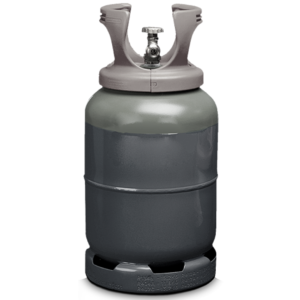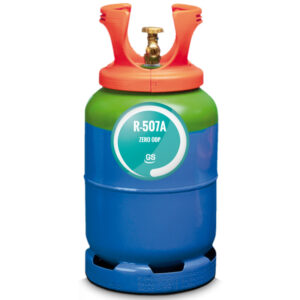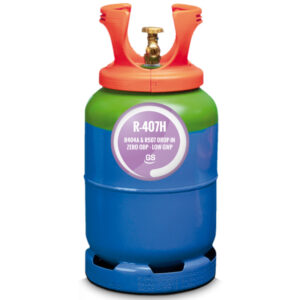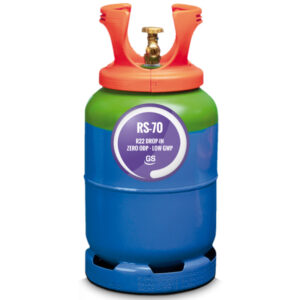R-23 is an azeotropic HFC refrigerant with zero ozone depletion used in new equipment operating at very low temperatures (around -60 to -100 °C). It is also an indirect substitute (retrofit) for R-13 and R-503.
R -23 is used only in cascade systems, at evaporating temperatures between -60 and -100 °C and condensing temperatures between -10 and -40 °C. Its thermodynamic properties are very similar to R-13.
Applications:
– Industrial refrigeration plants (e.g. gas separation and chemical processing).
– Pharmaceutical production plants.
– For medicinal purposes (e.g. blood banks).
– Materials testing.
– Cryomats and cryostats.
– High vacuum.
Using the same refrigerant charge with R-23 as with R-13 and R-503 requires a larger expansion tank. It is therefore recommended to charge R-23 initially using the same static pressure as we had with R-13 and R-503. The optimum load will be approximately 10-20% lower in weight than R-13 and R-503.
– Equipment can be refilled in case of leakage.
– Cooling capacity higher than R-13 and lower than R-503.
– Energy efficiency very similar to R-13 and lower than R-503 (10%).
– Lower suction pressure than R-503, and similar to R-13.
– Boiling point at 1,013 bar (ºC): -82
– Temperature glide or glide (ºC): 0
– Saturated vapor density at 25ºC (kg/m3): 370,37
NOTES:
-The reason why R-23 has a lower cooling capacity than R-503 is due to the increase in suction pressure and the molecular weight of R-503 compared to R-23.
– It should be taken into account for the design of new equipment or for a retrofit, that the compression ratio of R-23 is higher than that of R-13 and R-508.
– It may be necessary to adjust the expansion valve in a retrofit from R-503 to R-23 due to the high vapor pressures of R-503. Not required for R-13 retrofit. Why do we charge R-23 using static pressure? Because R-23 has a lower saturated vapor density than R-503 and R-13, retrofits with R-23 can result in higher static pressures. In the event that the unit heats up to ambient temperature in case of system shutdown, it may cause the presence of liquid at higher temperatures than R-13 and R-503, having the same refrigerant charge. Since the vapor pressure of the liquid increases more rapidly with temperature than the pressure exerted by the expansion of the gas, the static pressure of R-23 will be higher than that of R-13 and R-503 using the same system load and volume.
– 40 kg
– 11 kg
R-23 is an azeotropic HFC refrigerant with zero ozone depletion used in new equipment operating at very low temperatures (around -60 to -100 °C). It is also an indirect substitute (retrofit) for R-13 and R-503.
R -23 is used only in cascade systems, at evaporating temperatures between -60 and -100 °C and condensing temperatures between -10 and -40 °C. Its thermodynamic properties are very similar to R-13.
Applications:
– Industrial refrigeration plants (e.g. gas separation and chemical processing).
– Pharmaceutical production plants.
– For medicinal purposes (e.g. blood banks).
– Materials testing.
– Cryomats and cryostats.
– High vacuum.
Using the same refrigerant charge with R-23 as with R-13 and R-503 requires a larger expansion tank. It is therefore recommended to charge R-23 initially using the same static pressure as we had with R-13 and R-503. The optimum load will be approximately 10-20% lower in weight than R-13 and R-503.
– Equipment can be refilled in case of leakage.
– Cooling capacity higher than R-13 and lower than R-503.
– Energy efficiency very similar to R-13 and lower than R-503 (10%).
– Lower suction pressure than R-503, and similar to R-13.
– Boiling point at 1,013 bar (ºC): -82
– Temperature glide or glide (ºC): 0
– Saturated vapor density at 25ºC (kg/m3): 370,37
NOTES:
-The reason why R-23 has a lower cooling capacity than R-503 is due to the increase in suction pressure and the molecular weight of R-503 compared to R-23.
– It should be taken into account for the design of new equipment or for a retrofit, that the compression ratio of R-23 is higher than that of R-13 and R-508.
– It may be necessary to adjust the expansion valve in a retrofit from R-503 to R-23 due to the high vapor pressures of R-503. Not required for R-13 retrofit. Why do we charge R-23 using static pressure? Because R-23 has a lower saturated vapor density than R-503 and R-13, retrofits with R-23 can result in higher static pressures. In the event that the unit heats up to ambient temperature in case of system shutdown, it may cause the presence of liquid at higher temperatures than R-13 and R-503, having the same refrigerant charge. Since the vapor pressure of the liquid increases more rapidly with temperature than the pressure exerted by the expansion of the gas, the static pressure of R-23 will be higher than that of R-13 and R-503 using the same system load and volume.
– 40 kg
– 11 kg




